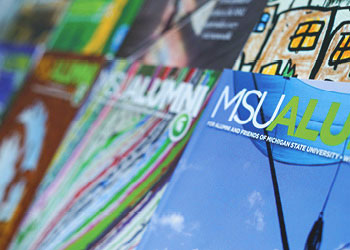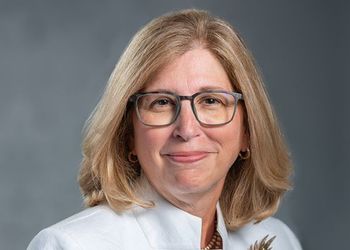Feature: MSU Strives to Lead in Sustainability Practices

With the opening of a new recycling facility, MSU’s “Be Spartan Green” initiative kicks into high gear.
More than a world leader in sustainable food and fuel research, Michigan State University is going to great lengths to model green practices on campus.
With 579 buildings on 5,200 acres frequented by 58,000 students, faculty and staff, MSU leaves a huge environmental footprint. It consumes 1.3 billion gallons of water a year, landfills 43,000 cubic yards of waste and operates a fleet of 2,000 vehicles. It emits some 600,000 tons of greenhouse gas annually, engineers estimate, the vast majority of which comes in the form of carbon dioxide released by its predominantly coal-fired steam and electricity generating plant.
But its conservation goals are big, too. Under its “Be Spartan Green” campaign (bespartangreen.msu.edu), MSU is committed to cutting energy consumption and greenhouse gas emissions by 15 percent and landfill waste 30 percent by 2015.
A new campus Green Certification program is expected to be rolled out during the national Campus Sustainability Week in mid-October, allowing operating units down to the residence hall room level to achieve certification by adopting best environmental practices. The university is a leader already in accountability, generating separate reports for each of its 779 campus buildings to track their energy use and waste recycling.
The university has won several accolades for its commitment, including recognition from the National Wildlife Federation and the Association for the Advancement of Sustainability in Higher Education. It’s also won support from corporations to help advance their own sustainability efforts. The Coca-Cola Co. in January awarded a $400,000 grant to MSU’s College of Agriculture and Natural Resources to help establish a new Center for Packaging Innovation and Sustainability.
Much of the on-campus stimulus for best practices comes from an environmental stewardship initiative revolving around the “Five R’s”—reduce; reuse/recycle; research/re-educate; redesign; and rethink. It has enlisted environmental stewards—faculty, staff and students representing each department and building—to raise awareness, serve as resource hubs for local action and as conduits for information up and down the chain to the Spartan Green Team that coordinates the program.
The initiative so far has developed 50 recommendations to conserve resources. Twenty-six of them, including recycling and alternative fuel use, have been implemented or are in process, officials reported. The others are to be undertaken within the next year—among them boosting niche recycling and taking Energy Star efficiency ratings into account in purchasing decision.
Strengthening stewardship is a strategic imperative of MSU President Lou Anna K. Simon’s Boldness By Design initiative, which specifies a systems design approach to manage the complexity of the campus and lays out environmental focus areas in systems management; energy reduction; materials strategies; purchasing recommendations; behavior and cultural change; and communication.
“The best part of the environmental stewardship initiative is that we can use MSU as a living, learning laboratory for our faculty, staff and students,” says Fred Poston, vice president for Finance and Operations. “Few universities are able to get the kind of collaboration that we’ve seen through environmental stewardship. The students involved in this project will take what they’ve learned at MSU and apply it to their careers and lives when they leave MSU.”
Low-hanging fruit has already been harvested. Some 170,000 square feet of building were added on campus last year, which normally would have added 0.7 percent to overall electric consumption. Yet conservation initiatives—now including e-mail reminders to shut down computers on long holiday weekends—resulted in net electric demand growth of only 0.25 percent, officials reported.
With financial belt-tightening a growing reality, energy savings are a double-bottom-line target, with projects underway ranging from burning alternative fuels at the T.B. Simon Power Plant to consolidating evening classes in fewer buildings. A pilot program last academic year involved rescheduling evening classes and events in seven buildings to nearby, more highly used facilities. Activities at Baker, Agriculture, Giltner and Olds halls and the Natural Resources, Old Horticulture and Urban Planning buildings were often relocated, allowing physical plant staff to close them down earlier and dial down the thermostats.
Energy savings from that program ranged up to 20 percent, thanks to coordination between Physical Plant personnel, the Registrar’s office, Academic Technology Services, and Facilities Planning and Space Management. The effort totaled some 211 fewer electrical megawatt-hours consumed, 137 tons less carbon dioxide emitted into the atmosphere and a savings of $16,904.
The experience is prompting MSU to expand the program to other campus buildings this year.
What can be measured can be managed, so teams of retrofitting specialists will visit more campus buildings this year to establish energy use baselines and recommend ways to dial down their energy consumption. Well-ventilated chemistry laboratory areas, for example, will be scrutinized for ways to shut down air flow when not in use, and the food science building will sport an indoor air quality sensor connected to its computerized thermostat to further eke out savings by ventilating only when necessary.
The combination of academic faculty and operations staff examining conservation measures has produced a powerful combination, applying rigorous research methods to practical means of promoting sustainability. A 2008 study of water use in restrooms in the Main Library by Agricultural, Food and Resource Economics Professor Scott Swinton and graduate research assistant Alexandra Peralta found that MSU could score dramatic savings in water use just by renovating pre-1992 restrooms—those receiving 16 or more uses daily—to meet current building codes. That alone could cut water use by 56 percent, the researchers reported, with more savings possible by using ultra-low flow fixtures.
At the same time, their report cautioned against an investment in relatively high-maintenance, touch-free hygienic technology until additional health or other benefits can be documented.
“Our systems team makes our approach to environmental stewardship unique,” Poston explains. “Some universities choose to focus on one area, such as recycling or energy reduction, but we are using a systems science approach to map out inputs to campus, processes on campus and outputs. Then our systems team makes data-driven recommendations that result in incremental change for lasting impact. We may not move as fast, but it is more important that we sustain our progress over time.”
Since April 2008 campus sources have cut purchase of white office paper by 20 percent, and increased cardboard collection by 35.6 percent and #1 and #2 plastic collections by 22 percent. The net effect is a 10 percent reduction in landfill waste, officials reported.
A new phase of the university’s recycling program calls for collection of boxboard, toner cartridges, household metals and more plastics and niche recycling.
Recycling kicks into a higher gear this season with the opening of a $13.3 million recycling facility, located west of Farm Lane in the university’s service district. It will triple campus recycling capacity. Together with a new comprehensive recycling program, it will allow recycling collection in all buildings, doubling the capture rate of five key materials by 2010. The recycling center is expected to pay for itself in 12 years.
Until now, MSU shipped collected recyclables in loose boxes that have to be processed off site. The new facility will enable materials to be sorted and shipped in bulk, promising a higher price paid by downstream processing facilities. “I think it will be great to have the recycling center and surplus store as a demonstration of what MSU is striving for,” says Lauren Olson, a project coordinator with the Office of Campus Sustainability.
Built to LEED (Leadership in Energy and Environmental Design) standards with a projected energy savings of 25 percent, the facility will include a number of energy- and resource-saving features, Physical Plant Energy and Environmental Engineer Lynda Boomer says. It will sport a 30-kilowatt solar array on the roof to reduce use of outside electricity, recapture heat from bathroom vent exhaust, collect rainwater for use in facility toilets and use room motion sensors to turn lights off and on.
The recycling center, which shares space with the MSU Surplus Store for additional synergies, also incorporates a new formulation of concrete developed by doctoral student Roz-Ud-Din Nassar in the lab of Engineering Professor Parviz Soroushian. Adding ground glass to the mix, Boomer says, produces a durable grade of concrete that readily uses even hard-to-recycle green glass.
The facility is part of the integrated environmental stewardship initiative President Simon outlined in her 2007 Boldness by Design initiative. “We are committed to significantly reducing MSU’s footprint by developing new techniques for managing this complex ecosystem of agriculture, research, office and living environments that constitute our campus community,” she said when the Board of Trustees green-lighted the recycling center in January 2008.
A more specific commitment was made in 2007 as part of MSU’s participation in the Chicago Climate Exchange, or CCX. MSU is an early member of the CCX, with a handful of representatives now sitting on its policy panels.
Members of the CCX, of which there are still only a few universities, pledge to reduce direct carbon emissions by conserving energy or providing opportunities to offset emissions by supporting no-till farming, tree farming or otherwise generating carbon “credits.” MSU promised to meet a six percent greenhouse gas reduction by 2010, but because that goal starts from a year 2000 baseline, the actual reduction necessary will be closer to 15 percent from today’s level, Boomer notes.
The university initially had to purchase credits for 5,000 tons of carbon, turning to fellow Big 10 CCX member, University of Iowa. That helped achieve MSU’s full committed reduction of 25,000 tons for 2007, before conservation programs could be implemented. Since then, MSU has purchased credits on the CCX from a third-party aggregator of credits from Michigan farms, Boomer says. Those farms generate credits by maintaining acreage in no-till status, which keeps carbon sequestered in the soil.
“We felt it was really important to keep the money in Michigan and help the Michigan farmers, and that’s a way to do it,” Boomer says. “All this is really preparing us for (anticipated regulatory) legislation.”
The T.B. Simon Power Plant accounts for about 500,000 tons of the 600,000 tons of carbon dioxide emitted by the university, utility services director Robert Ellerhorst says. The plant in recent months managed to cut its emissions while saving money by substituting natural gas for coal as fuel for boilers, when their relative prices made it financially worthwhile. Natural gas generates half the amount of carbon dioxide as coal per heat unit, he notes.
Now the department is lining up approvals to burn wood and switchgrass waste as part of a goal to replace at least 10 percent of the 25,000 tons of coal burned in the plant annually with alternative fuels. But the fossil fuel will remain the staple combustion source for the foreseeable future, Ellerhorst says.
“We think that, economically, coal is still the fuel for us and we believe we can continue to burn it in compliance with all the regulations,” he says. His department has been charged with developing an energy source master plan, envisioning operations in the year 2020.
Changing people’s behavior on campus could prove to be the greatest source of conservation, sustainability advocates say. Ellerhorst’s division, for example, is required to shut down computers if they’ll be idle for more than an hour. A “lights out” noon hour on campus last spring demonstrated a noticeable effect on campus electricity demand, Ellerhorst notes.
“We definitely saw that at the power plant, and some of (the electrical demand) came back after lunch and some of it didn’t,” he says. “That Friday load was definitely different from a weekday load, so there’s potential there.”
Other efforts to improve sustainable practices on campus abound. A 4,000-square-foot hoophouse at MSU’s 10-acre Student Organic Farm opened a year ago to serve Yakeley Hall with organic produce. Student Financial Services areas removed about half the light bulbs from first floor offices. Information technologists are adopting server virtualization software, cutting electronic’s energy demand.
Environmental Health and Safety organized car pools; replaced vehicles with biodiesel models, and a golf cart for campus trips; and encouraged employees to teleconference instead of travel when possible. Housing and Food Services reported a 10 percent cut in energy use in residence halls since January 2008 by installing energy-efficient lights and plumbing fixtures, tightening meeting room booking practices and modifying its heating/ventilation/air conditioning policy in accordance with university policy.
“Environmental stewardship makes sense for MSU,” Vice President Poston says. “As we work through tough economic times in Michigan, it benefits us to manage our resources as efficiently as possible. We have the advantage of having world-class faculty, staff and students that can do research right here on campus and produce recommendations that not only help the University, but provide economic and environmental solutions for communities in Michigan and around the world.”
Author’s note: Mark Fellowsis a communications manager in the Division of University Relations, covering science, environmental and economic development topics. He has a background in business journalism.
A GREEN THEME FOR HOMECOMING 2009
The MSU Alumni Association has adopted a theme, “We’ve Always Been Green,” for Homecoming 2009 to coincide with the university's "Be Spartan Green" environmental stewardship initiatives. Homecoming activities take place October 12-17 and will include the MSU Homecoming Parade, Grand Awards Ceremony, the Green & White Brunch, student and college events, and the annual Homecoming football game.
For more information and to register for events, visit www.msualum.com.



